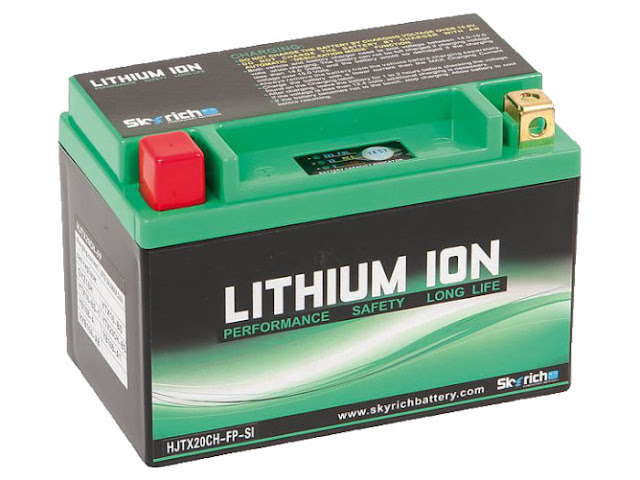
Chaaarge It! Motorcycle Battery Troubleshooting 101
A not-so-long time ago in a motorcycle accessory store not too far away, I overheard a conversation between two fellow riders. X advised Y to use a charger on Y’s bike battery (which was presumably flat). Y asked if he couldn’t just jumpstart and ride the bike instead. They’d walked out of earshot by then, so I didn’t hear X’s reply. So... Does riding your motorcycle charge its battery?
For motorcycles with internal combustion engines, riding the bike will charge up the battery IF everything is working normally. But an out-of-charge battery might be a sign that things aren’t working normally. In that case, charging the battery may require an external charger and additional repairs.
In this post, I’ll give you the jargon-free lowdown on motorcycle batteries and how they work. And importantly, why they sometimes don’t -- and what to do when that happens.

Before we go any further though, if you feel unsure of your ability to handle anything electrical, then proceed with caution when trying any of the tests or fixes described in (or linked from) this post. If you’ve never handled any circuitry before, I suggest you seek help with electrical tasks.
At least watch how it’s done firsthand, before attempting to do it yourself. Seriously. Making mistakes with your bike’s electrical system can hurt you or your bike or both. Don’t try to DIY unless you feel confident that you can follow the steps safely.
How Motorcycle Batteries Work
There was a time when motorcycles didn’t have batteries. But us motorcyclists are a pampered lot that expects extravagant gadgetry like headlights, turn signals, horns, and electric starters on our bikes. So, on most contemporary motorcycles, batteries are absolutely essential. (Except trail bikes. Many trail bikes can work just fine without batteries.)
How do these little plastic energy boxes work, though? Well, without getting too much into the chemistry, let’s just say that batteries convert chemical energy into electrical energy.
There are various types of motorcycle batteries, and the construction and chemistry involved can be very different across types. But all of them use reversible chemical reactions. When the battery charges, the reaction goes one way; when it discharges, the reaction goes the other. This only works a finite number of times, after the battery can no longer be recharged.
To keep their batteries juiced up, modern motorcycles use alternators or stators. (Technically, a “stator” is a subcomponent of an alternator, but because motorcyclists like to be confusing, the term is also used to describe a slightly different apparatus, as in the previous sentence.)
When your bike is running, the engine drives the alternator, which generates alternating current (AC). But the battery needs direct current (DC) for it to charge. The job of converting AC to DC is handled by a “rectifier”.
If everything is working the way it’s supposed to, the engine drives the alternator, the alternator supplies AC to the rectifier, which converts it to DC to charge up your battery. The battery then supplies DC to the rest of the gadgets and gizmos across your bike.
Why Does a Battery Go Flat?
Picture this. You walk up to your motorcycle and push the starter button.
Click.
And... nothing.
Instead of roaring into life like it normally does, your bike just gives you the cold shoulder, or coughs politely and gives you the silent treatment.
This is what a mechanic would call, “no crank”. It means that the crankshaft in the engine isn’t turning over. The first thing to make sure of at this point is that the no-crank condition isn’t because of something like forgetting to turn the ignition on (hey, it can happen to the best of us), leaving the side stand down, not being in neutral, or not pulling in the clutch.
If none of these things applies, chances are, you’re dealing with a battery / charging issue.
The terms “flat battery” and “dead battery” are often used interchangeably. For the sake of clarity, let’s say that a battery is flat if it has run out of charge, AND it can still be recharged. If it has run out of charge but it cannot be charged again, then it’s a dead battery.
A battery might go flat or dead for a variety of reasons:
- The alternator has failed (partially or completely), so the battery isn’t getting charged.
- The rectifier is burnt out, so again, the battery isn’t getting charged.
- The battery didn’t get charged because of a user-related factor, like forgetting the lights on, for instance.
- The battery got discharged too much, possibly because of too heavy a load connected to it, or a “leak” that’s causing current to get wasted.
- The battery has reached the end of its serviceable life, so it can’t be recharged any further.
These are just a few possible causes, and by no means a comprehensive list. The point is, the answer to whether riding your motorcycle will charge your battery, depends on what caused the flat battery to begin with.
If the charging system is faulty, riding the bike will not recharge the battery. Even charging the battery with an external charger is only going to fix things temporarily. On the other hand, if all that happened was that you left your ignition on all weekend, riding your bike should juice up the battery again -- provided that you can get your bike started (jump start / push start), and also that the battery wasn’t nearing the end of its lifespan in the first place.
This helpful video will show you how to get your bike started with a flat battery.
How to Deal With a Flat / Dead Battery
At this point, you’re probably asking: “So how can I tell what caused the flat battery?”
Well, if you really want to diagnose the issue, having a digital multimeter, at the very least, is going to take you quite far in your troubleshooting process.
Amazon has dozens of options. Honestly, you can just ignore the instruments that claim to be “specially designed” for automotive applications. They’re unnecessarily expensive. In my experience, any regular multimeter works just fine.
This one by Crenova is an excellent option (Amazon link). It costs less than $30, and for the life of me, I can’t figure out what some of the more expensive units costing in excess of $100 can do that this can’t.
There are even cheaper options too, of course, but I like that this Crenova unit comes with both, pin-type test leads and alligator clips. The latter are especially handy when you’re working alone. If you already have leads with clips lying around, you could save yourself a few bucks by getting something cheaper still.
Before you run off and buy anything though, you should probably check out what you’re supposed to do with it. The video is an excellent guide to troubleshooting your motorcycle’s charging system.
Importantly, you should know that not all types of batteries work the same way. Most bikes nowadays come with sealed lead-acid batteries as stock. Lithium polymer and lithium ion batteries are somewhat less common, but they have many advantages (lighter, smaller, lower rate of discharge, etc) over their lead-acid counterparts.
On the flipside, lithium batteries are also more fussy and difficult to maintain. Improperly handled lithium batteries can catch fire, or even explode. I should point out though, that while conventional sealed batteries are considered much safer, they’re not zero risk either.
There’s still a small chance that lead-acid batteries might leak hydrogen gas, especially if they’re old and in poor condition. As you know, if you hydrogen and sparks don’t go well together (think ‘kaboom’), so it’s always a good idea to work in a well-ventilated and spark-free environment.
The type of a battery is usually printed very clearly on its case. If your motorcycle does have a lithium type battery, check out the video below before you try to charge it or work with it in any way.
Summary
I hope this covers everything you need to know about charging and troubleshooting motorcycle batteries. As always, if you have a question or comment, do post in the comments below. I read and respond to every single reader comment.

